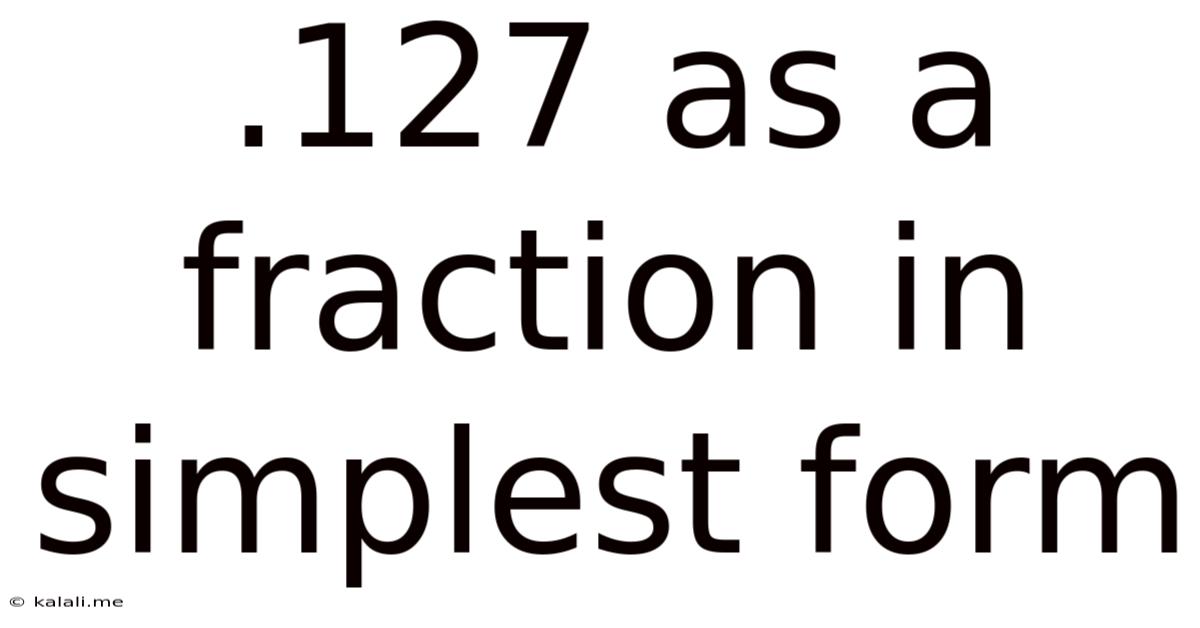.127 As A Fraction In Simplest Form
Kalali
Aug 19, 2025 · 4 min read

Table of Contents
.127 as a Fraction in Simplest Form: A Comprehensive Guide
This article explores the conversion of the decimal number 0.127 into its simplest fractional form. We'll break down the process step-by-step, offering various methods and explanations to ensure a thorough understanding. Understanding this conversion is fundamental for various mathematical applications and crucial for anyone working with numbers in different formats. We will also touch upon the broader concept of decimal-to-fraction conversion and explore practical applications of this skill.
Understanding Decimal to Fraction Conversion
Before diving into the specifics of converting 0.127, let's establish a foundational understanding of the process. Decimals represent parts of a whole number, expressed as a base-ten system. Fractions, on the other hand, represent parts of a whole as a ratio of two integers – the numerator (top number) and the denominator (bottom number). Converting a decimal to a fraction involves expressing the decimal value as a ratio.
The key to this conversion lies in recognizing the place value of each digit in the decimal. For example, in 0.127:
- 0.1 represents one-tenth (1/10)
- 0.02 represents two-hundredths (2/100)
- 0.007 represents seven-thousandths (7/1000)
By understanding these place values, we can build the fraction equivalent.
Converting 0.127 to a Fraction: The Step-by-Step Method
The most straightforward method involves using the place value of the last digit. In 0.127, the last digit (7) is in the thousandths place. This means the denominator of our fraction will be 1000.
-
Write the decimal as a fraction with a denominator of 1000:
0.127 = 127/1000
-
Simplify the fraction:
Now, we need to simplify this fraction to its lowest terms. This means finding the greatest common divisor (GCD) of the numerator (127) and the denominator (1000) and dividing both by it. Let's find the prime factorization of both numbers:
- 127 is a prime number; its only factors are 1 and 127.
- 1000 = 10³ = (2 x 5)³ = 2³ x 5³ = 2 x 2 x 2 x 5 x 5 x 5
Since there are no common factors between 127 and 1000 other than 1, the fraction 127/1000 is already in its simplest form.
Therefore, 0.127 as a fraction in simplest form is 127/1000.
Alternative Methods and Understanding Prime Factorization
While the above method is the most efficient for this specific decimal, let's explore other approaches and delve deeper into prime factorization, a crucial concept in simplifying fractions.
Method 1: Using the Place Value Directly
We can directly interpret the place value to construct the fraction. 0.127 is read as "one hundred twenty-seven thousandths," directly translating to 127/1000. This method bypasses the need for explicit place-value expansion.
Method 2: Focusing on Prime Factorization for Simplification
Prime factorization is the process of expressing a number as a product of its prime factors. This technique is critical for finding the greatest common divisor (GCD). Remember, the GCD is the largest number that divides both the numerator and denominator without leaving a remainder.
As we saw earlier, the prime factorization of 127 is simply 127 (it's a prime number), and the prime factorization of 1000 is 2³ x 5³. Because there are no common factors, the fraction is already in its simplest form.
Practical Applications of Decimal to Fraction Conversion
The ability to convert decimals to fractions is vital in various fields:
-
Engineering and Physics: Many calculations in engineering and physics involve fractions, especially when dealing with precise measurements and ratios. Converting decimals to fractions ensures accuracy and allows for easier manipulation in calculations.
-
Baking and Cooking: Recipes often require precise measurements, and fractions are common in culinary practices. Understanding decimal-to-fraction conversion enables precise ingredient measurements.
-
Finance: Financial calculations frequently involve fractions, particularly when dealing with interest rates, percentages, and ratios.
-
Mathematics: Understanding decimal-to-fraction conversion is fundamental for various mathematical operations, including simplifying expressions, solving equations, and working with proportions.
Further Exploration: Dealing with Repeating Decimals
While 0.127 is a terminating decimal (it ends after a finite number of digits), many decimals are repeating decimals (they continue indefinitely with a repeating pattern). Converting repeating decimals to fractions requires a slightly different approach involving algebraic manipulation. For instance, converting 0.333... (repeating 3) to a fraction involves:
- Let x = 0.333...
- Multiply by 10: 10x = 3.333...
- Subtract the first equation from the second: 10x - x = 3.333... - 0.333... This simplifies to 9x = 3.
- Solve for x: x = 3/9 = 1/3
This technique demonstrates how to handle repeating decimals, a slightly more complex scenario than converting terminating decimals like 0.127.
Conclusion: Mastering Decimal to Fraction Conversion
Converting decimals to fractions is a fundamental skill with numerous applications. The conversion of 0.127 to 127/1000, explained through various methods, highlights the simplicity and importance of this process. Understanding prime factorization and different approaches to simplifying fractions enhances mathematical proficiency and proves crucial in various practical situations. Mastering this skill will improve your abilities across different fields requiring numerical precision and manipulation. The ability to confidently convert decimals to fractions solidifies a strong foundation in mathematics and its real-world applications.
Latest Posts
Latest Posts
-
Scout How Old To Kill A Mockingbird
Aug 19, 2025
-
How Much Was A Cup Of Coffee In 1975
Aug 19, 2025
-
What Is A Flock Of Pheasants Called
Aug 19, 2025
-
A Promise Is A Comfort To A Fool
Aug 19, 2025
-
Cities That Start With C In America
Aug 19, 2025
Related Post
Thank you for visiting our website which covers about .127 As A Fraction In Simplest Form . We hope the information provided has been useful to you. Feel free to contact us if you have any questions or need further assistance. See you next time and don't miss to bookmark.